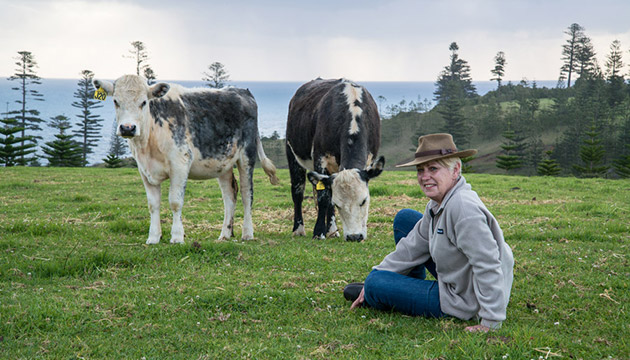The residents of Norfolk Island are putting their little slice of paradise on the gourmand’s map, thanks to unique produce and a big dose of enthusiasm.
Story By Tatyana Leonov
How do two brothers make cheese without any cows? It’s an unusual question, but the folk on Norfolk Island have been dealing with unusual for centuries. Australia’s only self-governed external territory, the pine-dotted subtropical Norfolk Island is a little slice of paradise in the Pacific. Today the tiny 8 x 5 kilometre volcanic outcrop is home to some of the best food in the country.
This can primarily be attributed to the unique ecosystem of Norfolk and the people who call it home. About a third of the population is descended from the rebellious Bounty crew and their Tahitian partners, a third come from mainland Australia and a third from New Zealand.
Glen and John Christian are direct Bounty descendants, although Glen lived in New Zealand prior to moving back to Norfolk a few years ago. “When I moved here brother John had been milking Roy’s [his father-in-law] cows,” he says. “Roy has two cows and the deal is that whoever milks them on that particular day gets to keep the milk. So I told Roy I’d like to learn how to milk a cow.” He pauses to laugh. “For about four months I was milking these cows by hand – it took me hours – three days a week. But we were drinking fresh milk, a rarity here on the island.”
Glen had studied cheesemaking in New Zealand and John is a microbiologist, so they started a boutique cheese business about three years ago. They not only craft cheese (feta, cheddar, haloumi and a cheese the brothers unassumingly call Dars-et, which means ‘that’s it’ in Norfolk), they run tours where guests can sample the hand-made cheeses along with local produce, such as guava jelly, avocados picked straight from the tree, home-made chutneys and honey. “We wanted to come up with a business model where we didn’t have to go out and buy any cows or – even worse – buy land to run the cows on,” John says.
Any island resident can legally own up to 10 licensed walkabout cows, no paddock required (cows get right of way on the roads), however 99% of the cows on the island are raised exclusively for beef.
“To keep the maths simple, let’s say a cow has a lifespan of two years,” John says. “After two years one cow is worth $900, on average. With our model we simply said: ‘If you let us milk your cow it might give us five litres a day. We’ll give you $5 a day. So at the end of the month you’ve got $150 for nothing. And at the end of two years you’ve got $2000 and a cattle animal that you can sell for $900.’” Glen laughs. “Or don’t let us milk it and you can have $900 at the end of two years. We’ve milked as little as two and just recently we’ve been given access to 15.”
This Story is from Issue #99
Outback Magazine: Feb/Mar 2015










